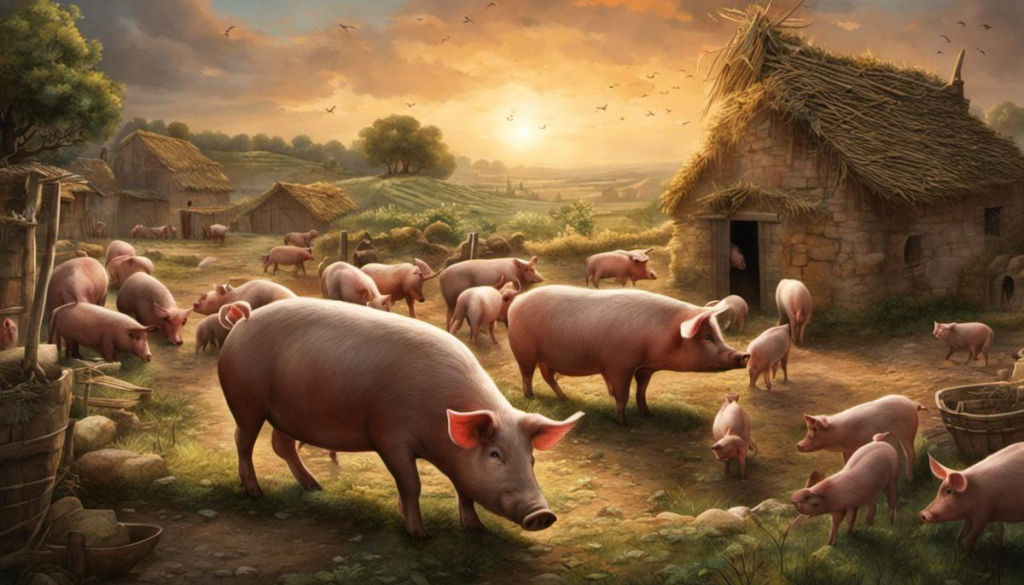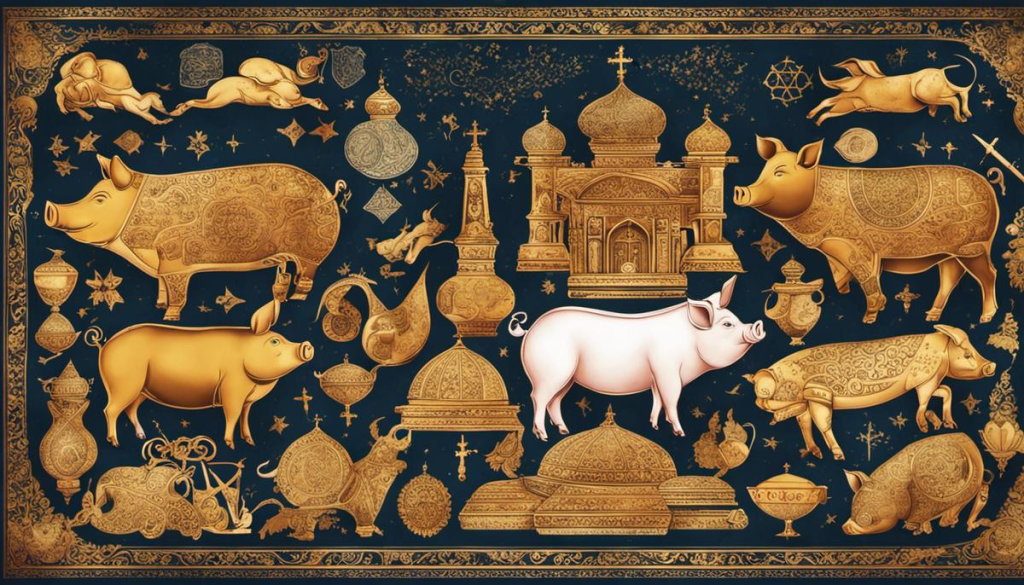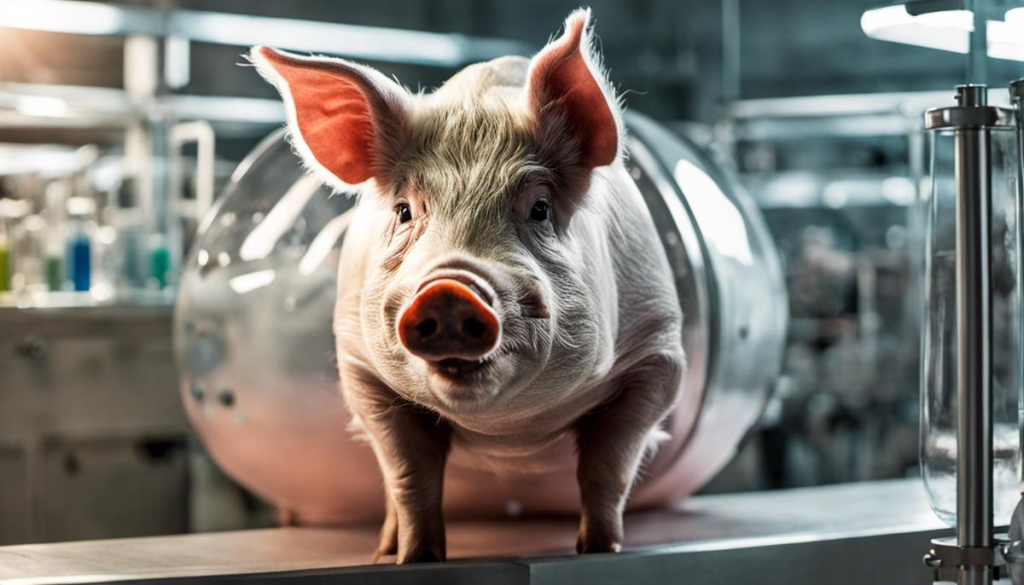Engulfed in an air of commonplace, pigs may appear to be just another farmyard animal. Yet their historical significance is immense, spanning areas as diverse as domestication, religion, agriculture, and modern medicine. Pigs have held an instrumental role since the dawn of human civilization, providing sustenance, supporting economies, and influencing sociocultural norms. Their influence even permeates into the far-fetched realms of religious devotion and folklore narratives, further underpinning their importance. In more recent times, their contribution towards life-saving medical advancements and pivotal genetic research is undeniable. This comprehensive exploration traces the captivating footprint of pigs across history and enlightens us on how they have skillfully trotted their way into our societies, religions, farmlands, labs, and ultimately, our hearts.

Domestication and Early Uses
Domestication of Pigs: The Advent of a Vital Livestock Animal
The historical significance of pigs extends as far back as 10,000 years ago when they were first domesticated in the Near East. The process started with wild boars and overtime, through selective breeding for favorable traits, these boars transformed into the pigs we recognize today. They were one of the first animals to be domesticated, primarily due to their speedy reproduction and their ability to adapt to diverse environments. Pigs played a pivotal role in the Neolithic Revolution, allowing humans to shift from hunter-gatherer lifestyles to settled farming communities.
The Significance of Pigs in Early Civilizations
In Ancient Egypt, pigs held dual roles – they were both a primary source of sustenance and an integral part of religious rituals. Preserved records reveal that they were one of the main meat sources for the Egyptians. Pigs were also commonly used for sacrificial offerings to the gods. In Roman civilization, pigs were similarly used for both dietary needs and religious rites. They believed that pigs had an innate ability to find underground resources, and they became symbolic for good fortune. Most notably, Roman author Varro wrote extensively about pig farming in his treatise on agriculture, highlighting the value of pigs as livestock.
The Spread of Pig Domestication
As civilizations progressed, pig domestication spread throughout different regions. Often, this was driven by trade but also occasionally by conquest. In the Bronze Age, as human societies developed, the transportation of pigs across Europe became more prevalent, providing a range of diverse pig breeds. Pigs provided a reliable and efficient source of protein and fat, necessary for the survival of these growing societies.
Soldiers often carried pigs with them during their conquests as a food source. Moreover, their widespread use in sacrificial offerings made them desirable trade items, widening their geographical reach.
The Role of Pigs in Early Human Cultures
Historically, pigs functioned as more than just a source of food and an object of religious significance. For instance, certain ancient civilizations utilized pig skin as material for shields, while the animal’s robust, dense bones made for useful tools. The pig’s fat was beneficial for both cooking and heating purposes, and their coarse bristles could be repurposed as brushes. Even pig feces were not ignored, proving to be a natural fertilizer for crops.
From this perspective, the importance of pigs throughout history transcends their original domestication and use for nourishment. With their various uses, pigs were seen as religious offerings, symbols of affluence and authority, critical elements in battle, and were even integrated into artistic and cultural practices, depending on the civilization and epoch.

Pigs in Religion and Folklore
Perceptions of Pigs in Christian Tradition
Within Christian traditions, pigs hold multiple symbolisms. Probably the most recognized narrative featuring pigs in the Christian Bible recounts Jesus expelling a legion of demons from a man and transferring them into a herd of pigs. These possessed pigs then plunged into a lake, succumbing to death and dragging the demons down with them. This depiction likely contributes to the connection between pigs and impurity or wickedness in Christian symbolism.
Nonetheless, pigs are not always attached with a negative connotation in Christianity. In Celtic Christian art, pigs figure as indicators of plenty and fertility. Prominent religious figures, such as St. Anthony, the patron saint of pig herders, had clear affiliations with pigs.
Pigs in Hinduism
In contrast to Christianity, pigs in Hindu tradition are associated with incarnation and knowledge. The Varaha avatar, one of Vishnu’s ten primary avatars, is depicted as a boar. In this form, Vishnu saved the earth from a demon who had submerged it into the cosmic ocean. Varaha is revered for his power and wisdom, symbolizing the conquering of ignorance and the attainment of knowledge.
Pigs in Islam and Judaism
Both Islam and Judaism have explicit religious laws that prohibit the consumption of pork. Pigs are considered unclean in both religions. In Islam, the ban is based on verses in the Quran that classify pigs as impure. Similarly, Jewish dietary laws, or Kashrut, label pigs as non-kosher because while they possess one sign of ritual purity (split hooves), they lack the other (chewing cud).
Pigs in Ancient Mythologies
In Greek mythology, pigs were associated with various deities like Dionysus, the god of wine and festivities, and Demeter, the goddess of agriculture and fertility. Meanwhile, in Norse mythology, the boar was a symbol of bravery, courage, and warrior spirit. The boar Freyja’s golden boar, Hildisvíni was considered as her lover and the Brisingamen replica. Freyr, a powerful god associated with virility and prosperity, likewise had a boar named Gullinbursti as his companion.
Cultural Perceptions and Societal Norms
The varied roles of pigs in different religions and cultural traditions have significantly impacted societal norms around these animals. The religious restrictions and taboos regarding pigs have influenced dietary practices, agricultural systems, and social behaviors in various cultures. For instance, countries with majority Muslim populations rarely breed or sell pigs due to the Islamic prohibition on consuming pork, shaping the agricultural market in these regions.
Conversely, in societies where pigs symbolize prosperity or abundance, they are often bred in large numbers and figure prominently in cultural celebrations and rituals. Some communities in the Pacific Islands, for example, view pigs as a form of wealth. Pigs are a common form of sacrifice in these societies, and the size of one’s pig herd can signify social status.
The cultural, religious, and social implications of pigs are profound and far-reaching. Whether considered sacred or profane, the historical symbolism and ubiquity of pigs in diverse cultures across the globe can’t be dismissed.

Pigs in Agricultural and Economic Developments
The Birth and Development of Porcine Agriculture
Since the Neolithic Age, pigs have formed a significant part of human existence, with the earliest evidence of pig domestication discovered in the Near East around 7000 BCE. The evolution of pig farming techniques highlights the integral role pigs have played in human civilization, especially in the agricultural and economic advancement.
Early pig rearing methods employed a natural, free-range system. Pigs were left to graze and rummage for food, including roots, grubs, and insects. Gradually, pig diets were supplemented with cereal feeds like barley and wheat bran, resulting in healthier pigs and improved growth rates. This marked a crucial turn in pig agriculture as it morphed into a viable economic activity.
The twentieth and twenty-first centuries witnessed transformative advancements in pig farming techniques. From focused genetic engineering and selective breeding to innovative feeding technology and disease management methods, modern science provided a means for longer-lived, more productive pigs. These changes didn’t just increase the output per unit; they also facilitated the shift from traditional subsistence farming to contemporary commercial pig farming.
Pigs in Feeding Populations
Throughout history, pigs played a critical part in feeding global populations due to their prolific reproduction and efficient meat production. Pigs can reproduce twice a year and yield litters of six to twelve piglets each time. Their rapid growth rate and high feed-conversion efficiency make them an unparalleled source of meat. Over the past fifty years, pork has been the most consumed meat worldwide, according to the Food and Agriculture Organization of the United Nations.
The versatility of the pig, coupled with its adaptability to various climates, add to its viability as a primary food source. Every part of a pig is usable for food. From trotters to jowls, different cultures worldwide have long-standing traditions of using almost every part of the pig, contributing to a waste-free system of food production.
Economic Impact and Significance
The economic significance of pigs goes beyond food production. In many societies, the ownership of pigs symbolized wealth and social status. Throughout history, pigs have served as a form of currency, their value fluctuating with the supply and demand dynamics of the economy.
In modern times, the pork industry is a multi-billion dollar global enterprise, employing millions of people worldwide in the sectors of farming, processing, distribution, and retail. The global rise in meat consumption has led to an increased demand for pork. Countries such as China, the United States, and Germany are not only leading consumers but are also major exporters of pork products.
The world pork market played a vital role in driving economic development, particularly in developing countries. Pig farming provides income opportunities to smallholder farmers who might not have the resources for larger-scale farming operations. Additionally, pigs contribute to the agricultural ecosystem by providing manure that aids in soil fertility, promoting crop production.
The Historical Importance of Pigs in the Global Food Industry
Throughout history, pigs have played a paramount role in the global food industry with pork products being a staple in myriad culinary traditions. From Italian prosciutto and Spanish chorizo to Chinese char siu and German bratwurst, the prominence of pork signifies the intrinsic part pigs play in the global food trade. The complexity of this contribution extends to stimulating international trade, enhancing GDP, and perpetually influencing the structure of the global food industry.
Indeed, the landscape of the global pork industry is often shaped by a variety of factors including fluctuating socio-economic conditions, political decisions, and outbreaks of diseases like African Swine Fever. Even variances in feed grain prices can pose a threat. Despite these challenges, the enduring demand for pork products stands testament to the resiliency and marked importance of pigs in the broader sphere of global agriculture.

Pigs in Modern Medicine and Genetics
The Pioneering Role of Pigs in Modern Medicine
Moving beyond the kitchen, pigs have also served a pioneering role in the advancement of modern medicine, specifically in organ transplantation. The process, known as xenotransplantation, involves the transfer of cells, tissues, or organs from one species to another. Owing to the physiological and anatomical similarities that pigs share with humans, pigs have been used extensively in these endeavours.
The experimentation with pig organs for transplant into humans dates back to the 20th century. One historical instance in 1964 saw Dr. James Hardy perform a lung transplant from a pig to a human, the first ever recorded attempt of such an operation. Though these initial endeavours were met with extensive challenges, such as immune rejection and preservation issues, they set the stage for intensive research and advancements in the field of xenotransplantation.
Pigs in Biological Studies
Outside of direct medical applications, pigs have also significantly contributed to our understanding of human biology. Due to the remarkable similarities between pig and human genomes, pigs are an excellent model for studying human diseases, like cardiovascular diseases, diabetes, and cancer.
In fact, the pig’s digestive system is so similar to that of humans that the food and drug industry often use pigs in preclinical trials to predict how certain substances will be metabolized or absorbed in the human body.
Advancements in Genetics: Pigs as a Model Organism
In terms of genetics, the role of pigs has been revolutionary. Scientists sequence the pig genome for the first time in 2012, providing critical insights into swine biology and evolution. This achievement paved the way for more sophisticated genetic studies focused on improving pig health and productivity, which also have significant implications for understanding human genetics and disease.
For instance, pigs share several disease-causing genetic mutations with humans, aiding in the identification of potential genetic targets for developing treatments. Furthermore, recent advancements in gene editing technologies, such as CRISPR, have leveraged the pig model to create genetically engineered pigs that can serve as models for human diseases or even as potential organ donors for xenotransplantation.
Pigs in Biomedical Research: Present and Future
Today, pigs continue to advance biomedical research. For example, in 2021, medical scientists successfully transplanted a genetically modified pig heart into a human patient for the first time. This could signal a significant breakthrough in addressing organ shortages.
Also, with the rise of gene editing technologies, researchers are harnessing the power of the pig model to advance our understanding of complex genetic disorders like cystic fibrosis, Alzheimer’s disease, and Parkinson’s disease.
Indeed, the historical significance of pigs stretches from early medical trials to modern genetics and biomedical research, and their role in the future of medicine and biological study is promising.

The journey of tracing the historical significance of pigs reveals a diverse and expansive narrative that resonates deeply with facets of human existence. These seemingly ordinary animals have in fact performed extraordinary roles, offering a strategic wealth of resources and insights that have shaped the trajectory of human civilization itself. Their roles in our societies and cultures, our agricultural practices, economies, and medical advancements all attest to an undeniable significance that transcends time and geographical boundaries. As such, pigs represent more than what meets the eye. They stand as a testament to the intricate and surprising connections that intertwine nature and humanity, reflecting an evolutionary synergy that continues to thrive. The humble pig, thus, deserves acknowledgment and respect for its substantial contribution throughout history and its certain continued relevance in our future.